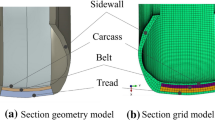Abstract
During the fire extinguishing process, the motion stability of the fire ladder truck can be affected by the jet reaction forces of the fire water monitor, lengths, vertical angles and horizontal angles of the fire ladder. This paper presents a virtual prototype method and its analysis of the effects of the aforementioned parameters on the motion stability of fire ladder truck under different working conditions during the braking process. An experiment analyzing fire water monitor jet reaction forces is established in this paper to obtain the forces under working conditions as the boundary conditions for the subsequent simulation analysis. During the simulation, two vertical pitch angles and three horizontal angles of the fire ladder are selected in this paper as the boundary conditions for the fire ladder truck motion stability simulations. The judgment standard of the motion stability of fire ladder truck is based on design criteria that the vehicle can maintain stability under braking operating working conditions if the maximum vertical pressure forces of all tires range from 0 N to 100,000 N. Thus, the findings based on the analysis results of this study can provide a theoretical foundation for the stability design of a fire ladder truck.

















Similar content being viewed by others
References
Guo T-N, Fu Z-M (2007) The fire situation and progress in fire safety science and technology in China. Fire Saf J 42(3):171–182. https://doi.org/10.1016/j.firsaf.2006.10.005
Yang L, Zhou X, Deng Z, Fan W, Qingan Wang (2002) Fire situation and fire characteristic analysis based on fire statistics of China. Fire Saf J 37(8):785–802. https://doi.org/10.1016/S0379-7112(01)00054-6
Zhong M, Fan W, Liu TM, Zhang PH, Wei X, Liao GX (2004) China: some key technologies and the future developments of fire safety. Saf Sci 42(7):627–637. https://doi.org/10.1016/j.ssci.2003.10.003
Yang S, Lu Y, Li, S (2013) An over view on vehicle dynamics. Int J Dyn Control 1(4):385–395. https://doi.org/10.1007/s40435-013-0032-y
Su Y, Liu ZY (2016) Numerical model of sloshing in rectangular tank based on Boussinesq-type equations. Ocean Eng 121:166–173. https://doi.org/10.1016/j.oceaneng.2016.05.003
Cao XY, Ming FR, Zhang AM (2014) Sloshing in a rectangular tank based on SPH simulation. Appl Ocean Res 47:241–254. https://doi.org/10.1016/j.apor.2014.06.006
Zhao DH, Zhiqiang CG, Serena L, Shuqi W (2018) Nonlinear sloshing in rectangular tanks under forced excitation. Int J Naval Archit Ocean Eng 10(5):545–565. https://doi.org/10.1016/j.ijnaoe.2017.10.005
Rumold W (2001) Modeling and simulation of vehicles carrying liquid cargo. Multibody Syst Dyn 5(4):351–374. https://doi.org/10.1023/A:1011425305261
Zheng X-L, Zhang H, Ren Y-Y, Wei Z-H, Song X-G (2017) Rollover stability analysis of tank vehicles based on the solution of liquid sloshing in partially filled tanks. Adv Mech Eng. https://doi.org/10.1177/1687814017703894
Li X-S, Zheng X-L, Ren Y-Y, Wang Y-N, Cheng Z-Q (2013) Study on driving stability of tank trucks based on equivalent trammel pendulum for liquid sloshing. Discrete Dyn Nat Soc. https://doi.org/10.1155/2013/659873
Toumi M, Bouazara M, Richard MJ (2009) Impact of liquid sloshing on the behavior of vehicles carrying liquid cargo. Eur J Mech A Solids 28(5):1026–1034. https://doi.org/10.1016/j.euromechsol.2009.04.004
Guha A, Barron RM, Balachandar R (2010) Numerical simulation of high-speed turbulent water jets in air. J Hydraul Res 48(1):119–124. https://doi.org/10.1080/00221680903568667
Yu Y, Shademan M, Barron RM, Balachandar R (2012) CFD study of effects of geometry variations on flow in a nozzle. Eng Appl Comput Fluid Mech 6(3):412–425. https://doi.org/10.1080/19942060.2012.11015432
Liang HG, Gang CW, Gang GZ (2010) Flow analysis of spray jet and direct jet nozzle for fire water monitor. Adv Mater Res 139:913–916. https://doi.org/10.4028/www.scientific.net/AMR.139-141.913
Chin SK, Jomaas G, Sunderland PB (2017) Firefighter nozzle reaction. Fire Technology 53(5):1907–1917. https://doi.org/10.1007/s10694-017-0661-3
Sun J, Li W, He M (2019) Analysis of fire water monitor jet reaction forces and their influences on the roll stabilities of urban firefighting vehicle. Fire Technol. https://doi.org/10.1007/s10694-019-00879-9
HM Fire Service Inspectorate Publications Section, Fire Service Manual-Volume 1-Fire Service Technology, Equipment and Media-Hydraulics, Pumps and Water Supplies, The Stationery Office, London, 2001
Vera F, Rivera R, Nez C (2015) Backward reaction force on a fire hose, myth or reality? Fire Technol 51:1023–1027
Video of the hose experiment. http://laplace.ucv.cl/Firehose/movimiento.html. Accessed 28 July 2014
Xiong GL, Guo B, Chen XB (2004) Co-simulation and virtual prototyping technology. Tsinghua University Press, Beijing
Hou B, Goncalves FD, Sandu C (2004) Dynamic simulation of a full vehicle with magneto-rheological damper. In: Proceeding of ASME IMECE, 6th annual symposium on advanced vehicle technology, Anaheim, pp 767–774
Ieluzzi M, Turco P, Montiglio M (2006) Development of a heavy truck semi-active suspension control. Control Eng Pract 14(3):305–312. https://doi.org/10.1016/j.conengprac.2005.03.019
Yang Y, Ren WQ, Chen LQ (2009) Study on ride comfort of tractor with tandem suspension based on multi-body system dynamics. Appl Math Model 33(1):11–33. https://doi.org/10.1016/j.apm.2007.10.011
Ren WQ, Zhang YQ, Jin GD (2005) Systematic research method for vehicle-road damage. China J Highw Transp 18(4):110–114
Lu YJ, Yang SP, Li SH (2010) Numerical and experimental investigation on stochastic dynamic load of a heavy duty vehicle. Appl Math Model 34(10):2698–2710. https://doi.org/10.1016/j.apm.2009.12.006
Yu ZS (2010) Automotive theory, 5th edn. China Machine Press, Beijing
Rajesh R (2006) Vehicle dynamics and control. Springer Press, New York
Verros G, Natsiavas S, Papadimitriou C (2005) Design optimization of quarter-car models with passive and semi-active suspensions under random road excitation. J Vib Control 11:581–606. https://doi.org/10.1177/1077546305052315
Parthasarathy SS, Srinivasa YG (2006) Design of an active suspension system for a quarter-car road vehicle model using model reference control. Proc Inst Mech Eng D 222(D8):1361–1373. https://doi.org/10.1243/095965105X33671
Cao JT, Liu HH, Li P, Brown DJ (2008) An interval type-2 fuzzy logic controller for quarter-vehicle active suspensions. Proc Inst Mech Eng D 222(D8):1361–1373. https://doi.org/10.1243/09544070JAUT0767
Popp K, Schiehlen W (1993) Fahrzeugdynamik. Teubner-Verlag, Stuttgart
Acknowledgements
This work is supported by National Key R&D Program of China (2016YFC0802900).
Author information
Authors and Affiliations
Corresponding author
Additional information
Publisher's Note
Springer Nature remains neutral with regard to jurisdictional claims in published maps and institutional affiliations.
Rights and permissions
About this article
Cite this article
Sun, J., Li, W., Li, B. et al. Motion Stability of Fire Ladder Truck Under Braking Process Working Conditions. Fire Technol 57, 313–340 (2021). https://doi.org/10.1007/s10694-020-00994-y
Received:
Accepted:
Published:
Issue Date:
DOI: https://doi.org/10.1007/s10694-020-00994-y




